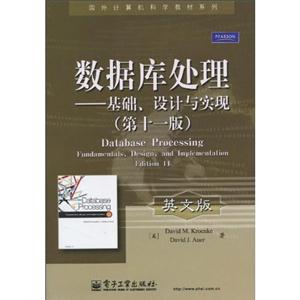数据库处理——基础、设计与实现(第十一版)(英文版) 目录
Preface xviiPART 1 GETTING STARTEDChapter 1:IntroductionChapter ObjectivesThe Characteristics of DatabasesA Note on Naming ConventionsA Database Has Data and RelationshipsDatabases Create InformationDatabase ExamplesSingle-User Database ApplicationsMultiuser Database ApplicationsE-Commerce Database ApplicationsReporting and Data Mining Database ApplicationsThe Components of a Database SystemDatabase Applications and SQLThe DBMSThe DatabasePersonal Versus Enterprise-Class Database SystemsWhat Is Microsoft Access?What Is an Enterprise-Class Database System?Database DesignDatabase Design from Existing DataDatabase Design for New Systems DevelopmentDatabase RedesignWhat You Need to LearnA Brief History of Database ProcessingThe Early YearsThe Emergence and Dominance of the Relational ModelPost-Relational DevelopmentsSummaryKey TermsReview QuestionsProject QuestionsChapter 2:Introduction to Structured Query LanguageChapter ObjectivesCape Codd Outdoor SportsThe Retail Sales Data ExtractionRETAIL_ORDER DataORDER ITEM DataSKU_DATA TableData Extracts Are CommonSQL BackgroundThe SQL SELECT/FROM/WHERE FrameworkReading Specified Columns from a Single TableReading Specified Rows from a Single TableReading Specified Columns and Rows from a Single TableSubmitting SQL Statements to the DBMSUsing SQL in Microsoft Access 2007Using SQL in Microsoft SQL Server 2008Using SQL in Oracle Database 11gUsing SQL in Sun Microsystems MySQL 5.1SQL Enhancements for Querying a Single TableSorting the ResultsSQL WHERE Clause OptionsCombing the SQL WHERE Clause and the SQL ORDER BY ClausePerforming Calculations in SQL QueriesUsing SQL Built-in FunctionsSQL Expressions in SQL SELECT StatementsGrouping in SQL SELECT StatementsLooking for Patterns in NASDAQ TradingInvestigating the Characteristics of the DataSearching for Patterns in Trading by Day of WeekQuerying Two or More Tables with SQLQuerying Multiple Tables with SubqueriesQuerying Multiple Tables with JoinsComparing Subqueries and JoinsSummaryKey TermsReview QuestionsProject QuestionsMarcia's Dry CleaningMorgan ImportingPART 2 DATABASE DESIGNChapter 3:The Eelational Model and NormalizationChapter ObjectivesRelational Model TerminologyRelationsCharacteristics of RelationsAlternative TerminologyFunctional DependenciesFinding Functional DependenciesKeysNormal FormsModification AnomaliesA Short History of Normal FormsNormalization CategoriesFrom First Normal Form to Boyce-Codd Normal FormEliminating Anomalies from Functional DependenciesEliminating Anomalies from Multivalued DependenciesFifth Normal FormDomain/Key Normal FormSummaryKey TermsReview QuestionsProject QuestionsMarcia's Dry CleaningMorgan ImportingChapter 4:Database Design Using NormalizationChapter ObjectivesAssess Table StructureDesigning Updatable DatabasesAdvantages and Disadvantages of NormalizationFunctional DependenciesNormalizing withChoosing Not to Use BCNFMultivalued DependenciesDesigning Read-Only DatabasesDenormalizationCustomized Duplicated TablesCommon Design ProblemsThe Multivalue, Multicolumn ProblemInconsistent ValuesMissing ValuesThe General-Purpose Remarks ColumnSummaryKey TermsReview QuestionsProject QuestionsMarcia's Dry CleaningMorgan ImportingChapter 5:Data Modeling with the Entity-Relationship ModelChapter ObjectivesThe Purpose of a Data ModelThe Entity-Relationship ModelEntitiesAttributesIdentifiersRelationshipsMaximum CardinalityMinimum CardinalityEntity-Relationship Diagrams and Their VersionsVariations of the E-R ModelE-R Diagrams Using the IE Crow's Foot ModelStrong Entities and Weak EntitiesID-Dependent EntitiesNon-ID-Dependent Weak EntitiesSubtype EntitiesPatterns in Forms, Reports, and E-R ModelsStrong Entity PatternsID-Dependent RelationshipsMixed Identifying and Nonidentifying PatternsThe For-Use-By PatternRecursive PatternsThe Data Modeling ProcessThe College ReportThe Department ReportThe Department/Major ReportThe Student Acceptance LetterSummaryKey TermsReview QuestionsProject QuestionsMarcia's Dry CleaningMorgan ImportingChapter 6:Transforming Data Models into Database DesignsChapter ObjectivesCreate a Table for Each EntitySelecting the Primary KeySpecifying Candidate (Alternate) KeysSpecify Column PropertiesVerify NormalizationCreate RelationshipsRelationships Between Strong EntitiesRelationships Using ID-Dependent EntitiesRelationships with a Weak Non-ID-Dependent EntiyRelationships in Mixed Entity DesignsRelationships Between Supertype and Subtype EntitiesRecursive RelationshipsRepresenting Ternary and Higher-Order RelationshipsRelational Representation of the Highline University Data ModelDesign for Minimum CardinalityActions When the Parent Is RequiredActions When the Child Is RequiredImplementing Actions for M-O RelationshipsImplementing Actions for O-M RelationshipsImplementing Actions for M-M RelationshipsDesigning Special Case M-M RelationshipsDocumenting the Minimum Cardinality DesignAn Additional ComplicationSummary of Minimum Cardinality DesignThe View Ridge Gallery DatabaseSummary of RequirementsThe View Ridge Data ModelDatabase Design with Data KeysMinimum Cardinality Enforcement for Required ParentsMinimum Cardinality Enforcement for the Required ChildColumn Properties for the View Ridge Database Design TablesSummaryKey TermsReview QuestionsProject QuestionsMarcia's Dry CleaningMorgan ImportingPART 3 DATABASE IMPLEMENTATIONChapter 7:SQL for Database Construction and Application ProcessingChapter ObjectivesThe View Ridge Gallery DatabaseSQL DDL, DML, and a New Type of Join……PART 4 MULTIUSER DATABASE PROCESSINGPART 5 DATABASE ACCESS STANDARDSAPPENDICESBibliographyGlossaryIndex
展开全部
数据库处理——基础、设计与实现(第十一版)(英文版) 相关资料
插图:Wow!That was a full chapter!Structured Query Language (SQL) was developed by IBM and has been endorsed by the ANSI SQL-92 and following standards. SQL is a data sublanguage that can be embedded into full programming languages or submitted directly to the DBMS. Knowing SQL is critical for knowledge workers, application programmers, and database administrators.All DBMS products process SQL. Access hides SQL, but SQL Server, Oracle, DB2, and MySQL require that you use itThere are basically two kinds of SQL statements: DML and DDL statements. DML statements include statements for querying data and for inserting, updating, and deleting data. This chapter addresses only DML query statements.The examples in this chapter are based on three tables extracted from the operational database at Cape Codd Outdoor Sports. Such database extracts are common and important. Sample data for the three tables is shown in Figure 2-4.The basic structure of an SQL query statement is SELECT/FROM/WHERE. The columns to be selected are listed after SELECT, the table(s) to process is listed after FROM, and any restrictions on data values are listed after WHERE. In a WHERE clause, character and date data values must be enclosed in single quotes. Numeric data need not be enclosed in quotes. You can submit SQL statements directly to Access, SQL Server, Oracle, and MySQL, as described in this chapter.















